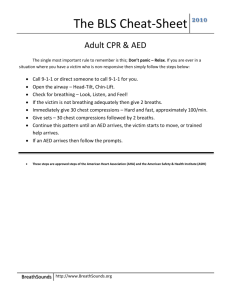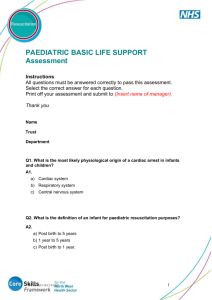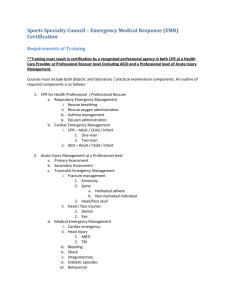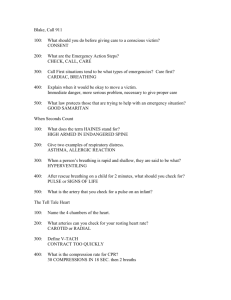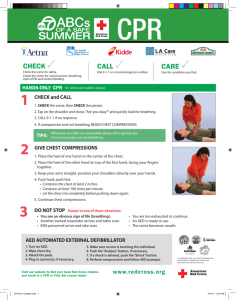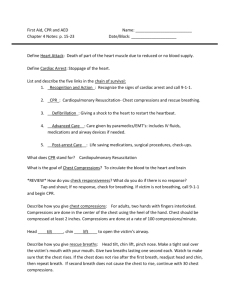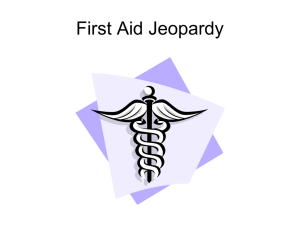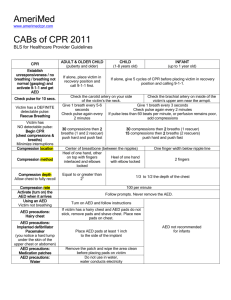The ABC's Of CPR
advertisement
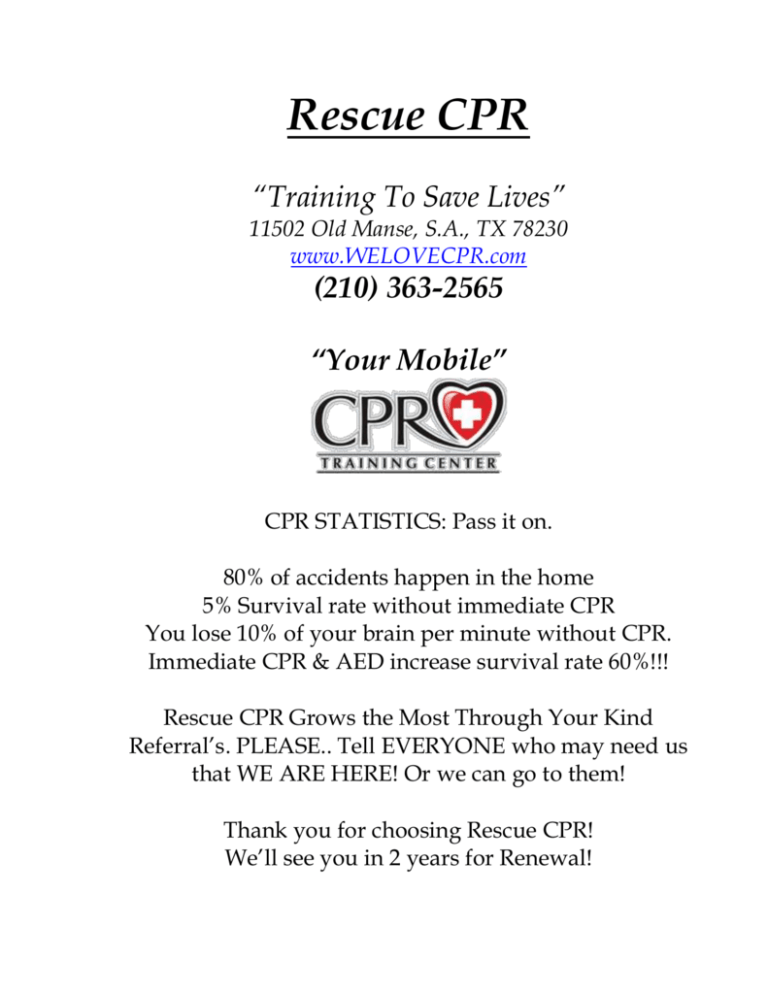
Rescue CPR “Training To Save Lives” 11502 Old Manse, S.A., TX 78230 www.WELOVECPR.com (210) 363-2565 “Your Mobile” CPR STATISTICS: Pass it on. 80% of accidents happen in the home 5% Survival rate without immediate CPR You lose 10% of your brain per minute without CPR. Immediate CPR & AED increase survival rate 60%!!! Rescue CPR Grows the Most Through Your Kind Referral’s. PLEASE.. Tell EVERYONE who may need us that WE ARE HERE! Or we can go to them! Thank you for choosing Rescue CPR! We’ll see you in 2 years for Renewal! The ABC’s Of CPR After confirming the victim is unresponsive follow ABC’s! AIRWAY : The preferred way to open a victim’s airway is the Head Tilt Chin Lift. It attempts to keep the tongue from slipping to back of mouth & obstructing the airway passage. Healthcare Providers If you know the jaw thrust technique and head or neck trauma id suspected - use it instead of head tilt. BREATHING : Rescuers should always do a breathing check prior to giving air! To check breathing LOOK, LISTEN, FEEL! Place ear over the victim’s nose & mouth for 5 – 10 seconds. If no breaths are felt, give 2 slow breaths of air ( pinch the nose of adult or child / cover the infants nose & mouth with your mouth.) If possible use a barrier device such as face shield or ambu-bag. CIRCULATION : Rescuers should always check for circulation by using carotid artery for adult/child victims OR brachial artery for infants. 5 – 10 Seconds no pulse is felt or pulse is less than 60 BPM (beats per minute) on children & infants, begin compressions. REMEMBER TO CALL 911 FOR HELP! Chain of Survival. Adults – Call right away! When you find the victim unresponsive. Children & Infants – do CPR 2 minutes (5 cycles) before calling 911 If victim is found with a pulse (children & infants 60bpm or better) begin your RESCUE BREATHING!!! Infants – 1 breath every 3-4 seconds Children – 1 breath every 4-5 seconds Adults – 1 breath every 5-6 seconds Infant CPR : The Basics 3 Main parts to infant CPR: 1)Airway 2) Breathing 3) Circulation Check for unresponsiveness by tapping the infants foot. Baby wake up! Are you ok? Open victim’s AIRWAY using the HEAD TILT - CHIN LIFT technique. Position ear over victim’s nose & mouth looking towards the chest. You will LOOK, LISTEN & FEEL for BREATHS of air for 5 – 10 seconds. If you DON’T hear, see or feel breathing – Give 2 SMALL Puffs of Air.. (an infants lungs are not fully developed & can collapse with strong breath) To check CIRCULATION, rescuer should use the brachial artery for 5 – 10 seconds. IF PULSE IS LOWER THAN 60 bpm – BEGIN COMPRESSIONS! CHEST COMPRESSIONS (Rate is 100 compressions per minute – very fast) Location for Chest Compressions in Infants is Nipple line or slightly below. Position your THUMBS in center of chest. Fingers of left hand go over the Shoulders & the fingers of the right hand hold by infants ribs & tummy. We will go 1/3 to 1/2 the depth of the chest (.5 to 1 inch deep!) FOR INFANTS 911 is called AFTER 5 cycles of CPR! This is true for CHILDREN & INFANTS due to Respiratory arrest NOT cardiac arrest. Note* Compression Rate at 100 compressions per minute is at the same speed as the music to Staying Alive! Staying Alive, Ah, Ah, Ah, Ah, Staying Alive, Staying Alive!!! Infant Choking Management Early recognition & knowing when to assist can be key for success! If the victim can COUGH, has wheezing between coughs or has good air exchange, the obstruction may be mild. Stay with the victim but DO NOT interfere with their attempt to cough up their obstruction on their own! If the victim has ANY of the following: Weak or no cough. No cry or breathing noise. Turning BLUE (face color) Has difficulty breathing. Has high pitched noise. This is the sign of a COMPLETLY blocked airway! Attempt to assist victim. There are NO MORE BLIND FINGER SWEEPS! If you can see what the item is put 2 fingers in mouth & pinch item out. IF YOU CANNOT SEE ITEM you can sit or kneel with infant on your lap. Hold the infant face down on your arm supporting the head by holding chin & cheeks (do not block the mouth) Begin 5 back slaps using the palm of your hand on center of back between infants shoulder blades. BE FORCEFUL & hit downward. Next turn infant face up while supporting head & neck. Give 5 chest thrust in the same location you would for CPR just below nipple line. Continue cycles 5 backslaps & 5 chest thrusts until object is dislodged or infant becomes unresponsive. If the INFANT BECOMES UNRESPONSIVE Lower to the ground & begin the steps of CPR with a few exceptions. Prior to giving breaths do 30 compressions & a visual mouth check. Only if you see the object should you attempt to remove it. If you do not see the object attempt to give 2 breaths (item may be pushed into the lung allowing victim to breathe. Follow this cycle. Activate 911 system when the victim becomes unresponsive! Adult / Child CPR : The Basics 4 Main parts to adult / child CPR: 2) Airway 2) Breathing 3) Circulation 4) AED (Defibrillation) Check for unresponsiveness by tapping on the victims shoulders. Mister / Misses wake up! Are you ok? Open victim’s AIRWAY using the HEAD TILT - CHIN LIFT technique. Position ear over victim’s nose & mouth looking towards the chest. You will LOOK, LISTEN & FEEL for BREATHS of air for 5 – 10 seconds. If you DON’T hear, see or feel breathing – Give 2 Breaths of Air.. To check CIRCULATION, rescuer should use the carotid artery for adult & children victims for 5 – 10 seconds. No Pulse – BEGIN COMPRESSIONS! CHEST COMPRESSIONS (Rate is 100 compressions per minute – very fast) Location for doing Chest Compressions for ALL AGES is the Nipple line. Adults compressions are about 2 inches deep. Child is ½ to 1/3 of chest. Adults / Children : with 2 hands use the heel of the hand positioned between the nipple line ( 1 hand is ok for children or small adult). Adult 1 or 2 Rescuer : 30 compression : 2 breaths Child/Infant 1 Rescuer : 30 compression : 2 breaths Child/Infant 2 Rescuer : 15 compression : 2 breaths 30 compression : 2 breaths = 1 Cycle Complete 5 Cycles before reassessment by pulse check. Allow the heart to RECOIL by taking the weight off of the chest to allow the heart to come back to it’s natural position after each compression. This will allow the heart to re-open / re-fill before next compression. Adult / Child Choking Management Early recognition & knowing when to assist can be key for success! If the victim can COUGH, has wheezing between coughs or has good air exchange, the obstruction may be mild. Stay with the victim but DO NOT interfere with their attempt to cough up their obstruction on their own! If the victim has ANY of the following: Weak or no cough, turning BLUE No cry or breathing noise. Has difficulty breathing. Has high pitched noise. This is the sign of a COMPLETLY blocked airway! Attempt to assist victim. There are NO MORE BLIND FINGER SWEEPS! If you can see what the item is put 2 fingers in mouth & pinch item out. Always start by asking the victim “Are you Choking?” & “Can I help you?” Location for All Abdominal Thrust is the BELLY BUTTON! Locate It! Position yourself behind victim (keep victim at your hip / put your leg between both of their legs) & wrap arms around victims waist. Use one hand to locate victims belly button & make fist with hand. Place THUMB side of fist towards abdomen just above belly button. Grasp other hand around the outer part of your fist & give continuous upward thrusts until victim dislodges object or becomes unresponsive Using a grunt or loud sound when giving thrusts helps give stronger thrust. With SMALLER children – not your height – kneel behind them or place them on a chair (anything of proper height where belly button is reachable. Their feet MUST remain flat on the floor at all times… SHORT STORY : Did you know that a grown woman was choking, when the male nurse panicked as he saw his partner’s abdominal thrusts were not working! The male nurse grabbed the woman and flipped her upside down in a bear hug & began to shake in down & up movements. Thanks to Gravity she threw everything up & was just fine! Honest Truth, same thing happened to us with our daughter & we did this, also panicked – it worked! Basic Steps to Operate an AED AED : A Computerized medical device that is available in many public places & is designed to be used with CPR. AED Statistics : survival rate goes up from 5% up to anywhere between 40% – 60% according to AHA statistics. When to Use AED : (Cannot be used on an Infant!!!) If victim is adult or child & not responsive. Has no breathing Has no pulse 2 Rescuers : 1 begins steps of CPR & 1 activates 911 & gets AED. 1 Rescuer : they should first call 911, then get the AED, then CPR. AED arrives : Place AED on side where Rescuer is operating it. Steps to operate an AED Power on the AED Remove pads from package & attach to bare chest Clear Victim to allow AED to analyze heart rhythm Clear All Rescuers!!! Push the shock button to deliver a shock if AED prompts you to shock. (No shock needed-begin CPR) CPR ALWAYS BEGINS with Chest Compressions Special Situations : Additional issues that require certain steps! Victim has a hairy chest – hair may interfere with shock. (some AED’s come with a special situations kit that includes a razor. OR you can use an extra set of electrode pads to do a quick wax job!) Victim is covered in water – try to dry or move victim to a dry location (look for a towel in a special situations kit.) Victim has an implanted AID or pacemaker – place electrode pad at least one inch away below device. Victim has a medication patch - remove with the towel! VICTIM IS AN INFANT!!! DO NOT USE ON INFANTS! Glossary of Terms AED : Automated External Defibrillator, a computerized medical device used by layperson or professional to defibrillate victims heart prior to EMS Agonal : Inadequate, as in not enough breathing. Often occurs within the first minutes of Cardiac Arrest where victim is only gasping for air. Basic Life Support : Life saving skills –when performed by a rescuer, can increase chances of survival. Skills include Cardiopulmonary Rescuscitation, Rescue Breathing, AED, & / OR Choking Management. Brachial Artery : Recommended location for an Infant pulse check. Upper part of the infants ARM below shoulder near the underarm. Chain of Survival : Key elements that summarize the best approach for treatment of victims of sudden cardiac arrest. Adult : Early 911, Early CPR, Early Defibrillation, Early Advanced Care Pediatric : Prevent Injuries, Early CPR, Early 911, Early Advanced Care Carotid Artery : Recommended location for pulse check on adult & child victims. Located on the neck just to the side of the adam’s apple location. Life-Threatening Situations : The 4 Major Types of medical emergencies that may cause the heart or lungs to shut down & require a rescuer to perform CPR / BLS inlude Cardiac Arrest, Heart Attack, Choking & Stroke. Recoil : Allowing the chest to return to it’s natural position which allows the heart to open & refill. During the chest compressions rescuer should take weight off their hands to allow the heart to recoil, without losing contact. Recovery Position : Placing the victim their side IF the victim is breathing on their own & has an adequate pulse BUT must be left unattended for short periods of time. This decreased the chances of victim choking on their own tongue, mucus, or vomit. Respiratory Arrest : The Absence of respirations ( breathing ). Which is a very common life threatening Medical Emergency in children & infants.
